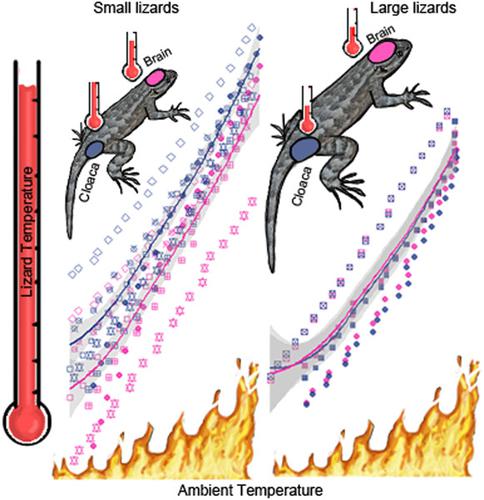当前位置:
X-MOL 学术
›
J. Exp. Zool. Part A
›
论文详情
Our official English website, www.x-mol.net, welcomes your feedback! (Note: you will need to create a separate account there.)
Body size impacts critical thermal maximum measurements in lizards
Journal of Experimental Zoology Part A ( IF 2.8 ) Pub Date : 2020-08-26 , DOI: 10.1002/jez.2410 Natalie M Claunch 1 , Emmeleia Nix 1 , Averil E Royal 1 , Luis P Burgos 1 , Megan Corn 1 , P Mason DuBois 1 , Kathleen N Ivey 1 , Elina C King 1 , Kiley A Rucker 1 , Tanner K Shea 1 , John Stepanek 1 , Sunny Vansdadia 1 , Emily N Taylor 1
Journal of Experimental Zoology Part A ( IF 2.8 ) Pub Date : 2020-08-26 , DOI: 10.1002/jez.2410 Natalie M Claunch 1 , Emmeleia Nix 1 , Averil E Royal 1 , Luis P Burgos 1 , Megan Corn 1 , P Mason DuBois 1 , Kathleen N Ivey 1 , Elina C King 1 , Kiley A Rucker 1 , Tanner K Shea 1 , John Stepanek 1 , Sunny Vansdadia 1 , Emily N Taylor 1
Affiliation

|
Understanding the mechanisms behind critical thermal maxima (CTmax; the high body temperature at which neuromuscular coordination is lost) of organisms is central to understanding ectotherm thermal tolerance. Body size is an often overlooked variable that may affect interpretation of CTmax, and consequently, how CTmax is used to evaluate mechanistic hypotheses of thermal tolerance. We tested the hypothesis that body size affects CTmax and its interpretation in two experimental contexts. First, in four Sceloporus species, we examined how inter‐ and intraspecific variation in body size affected CTmax at normoxic and experimentally induced hypoxic conditions, and cloacal heating rate under normoxic conditions. Negative relationships between body size and CTmax were exaggerated in larger species, and hypoxia‐related reductions in CTmax were unaffected by body size. Smaller individuals had faster cloacal heating rates and higher CTmax, and variation in cloacal heating rate affected CTmax in the largest species. Second, we examined how body size interacted with the location of body temperature measurements (i.e., cloaca vs. brain) in Sceloporus occidentalis, then compared this in living and deceased lizards. Brain temperatures were consistently lower than cloacal temperatures. Smaller lizards had larger brain‐cloacal temperature differences than larger lizards, due to a slower cloacal heating rate in large lizards. Both live and dead lizards had lower brain than cloacal temperatures, suggesting living lizards do not actively maintain lower brain temperatures when they cannot pant. Thermal inertia influences CTmax data in complex ways, and body size should therefore be considered in studies involving CTmax data on species with variable sizes.
中文翻译:

体型影响蜥蜴的关键最大体温
了解生物体的临界热最大值(CTmax;失去体温时,神经肌肉协调能力丧失的体温过高)背后的机制,对于了解电等温耐受性至关重要。体型是一个经常被忽略的变量,可能会影响CTmax的解释,从而影响CTmax如何用于评估热耐受性的机械假设。我们在两个实验环境中检验了身体大小会影响CTmax及其解释的假设。首先,在四个Seloporus物种,我们研究了常氧和实验诱导的低氧条件下体内和种内物种差异如何影响CTmax以及常氧条件下泄殖腔升温速率。在较大的物种中,体重与CTmax之间的负相关关系被夸大,而与缺氧相关的CTmax降低不受体重的影响。较小的个体具有更快的泄殖腔加热速率和更高的CTmax,而泄殖腔加热速率的变化会影响最大物种的CTmax。其次,我们研究了体型如何与西方Sc骨中体温测量值的位置(即泄殖腔对大脑)相互作用,然后在活着的和死去的蜥蜴中进行了比较。脑温度始终低于泄殖腔温度。较小的蜥蜴与较大的蜥蜴相比,其脑泄殖腔温度差异更大,这是由于较大的蜥蜴的泄殖腔加热速率较慢。活蜥蜴和死蜥蜴的大脑温度都低于泄殖腔温度,这表明活蜥蜴无法喘气时不会主动保持较低的大脑温度。热惯性以复杂的方式影响CTmax数据,因此,在涉及具有可变大小物种的CTmax数据的研究中,应考虑人体大小。
更新日期:2020-08-26
中文翻译:

体型影响蜥蜴的关键最大体温
了解生物体的临界热最大值(CTmax;失去体温时,神经肌肉协调能力丧失的体温过高)背后的机制,对于了解电等温耐受性至关重要。体型是一个经常被忽略的变量,可能会影响CTmax的解释,从而影响CTmax如何用于评估热耐受性的机械假设。我们在两个实验环境中检验了身体大小会影响CTmax及其解释的假设。首先,在四个Seloporus物种,我们研究了常氧和实验诱导的低氧条件下体内和种内物种差异如何影响CTmax以及常氧条件下泄殖腔升温速率。在较大的物种中,体重与CTmax之间的负相关关系被夸大,而与缺氧相关的CTmax降低不受体重的影响。较小的个体具有更快的泄殖腔加热速率和更高的CTmax,而泄殖腔加热速率的变化会影响最大物种的CTmax。其次,我们研究了体型如何与西方Sc骨中体温测量值的位置(即泄殖腔对大脑)相互作用,然后在活着的和死去的蜥蜴中进行了比较。脑温度始终低于泄殖腔温度。较小的蜥蜴与较大的蜥蜴相比,其脑泄殖腔温度差异更大,这是由于较大的蜥蜴的泄殖腔加热速率较慢。活蜥蜴和死蜥蜴的大脑温度都低于泄殖腔温度,这表明活蜥蜴无法喘气时不会主动保持较低的大脑温度。热惯性以复杂的方式影响CTmax数据,因此,在涉及具有可变大小物种的CTmax数据的研究中,应考虑人体大小。



























 京公网安备 11010802027423号
京公网安备 11010802027423号